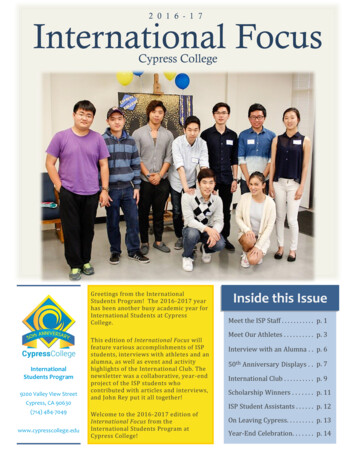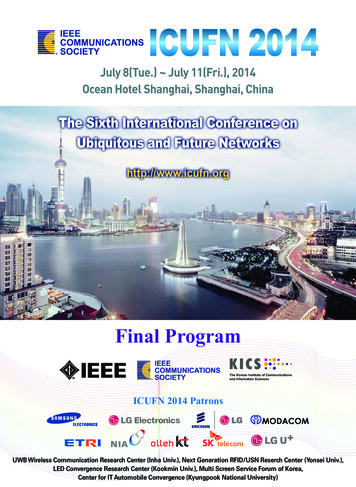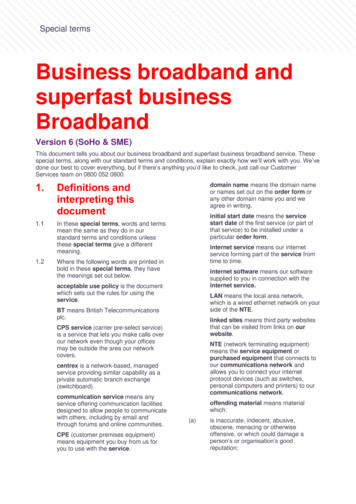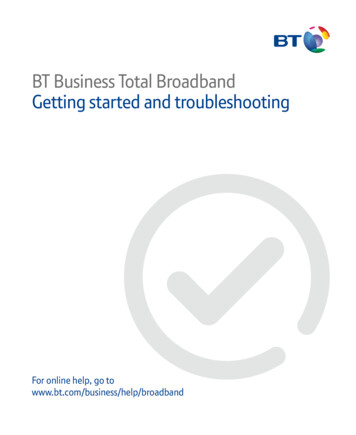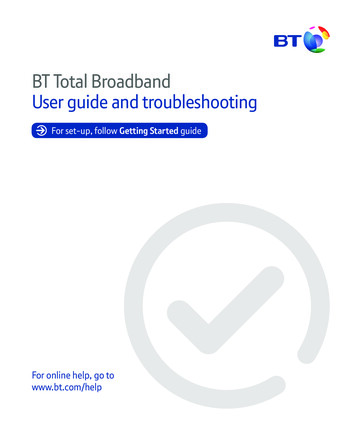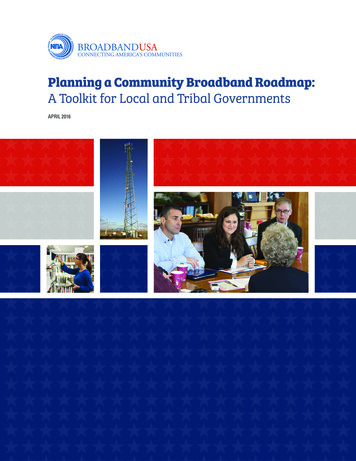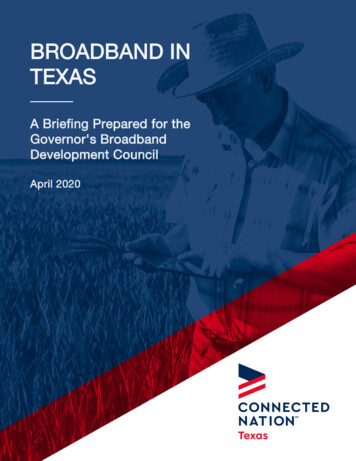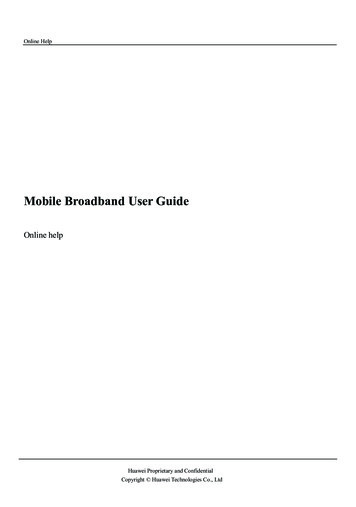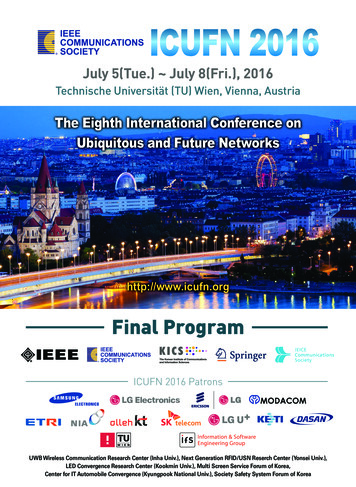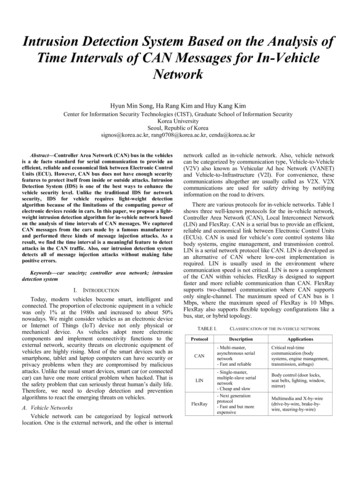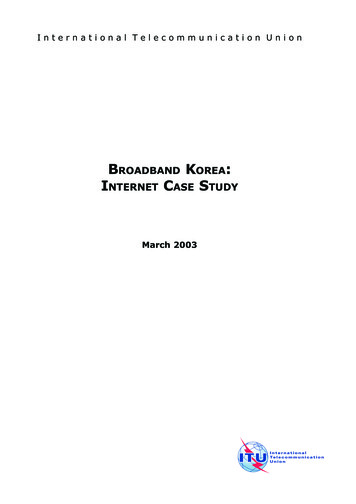
Transcription
International Telecommunication UnionBROADBAND KOREA:INTERNET CASE STUDYMarch 2003
This report was prepared by Tim Kelly, Vanessa Gray and Michael Minges. It is basedon research carried out from 23 to 30 May 2002 as well as articles and reports notedin the document. The assistance of the Ministry of Information and Communication,particularly Sang-Hak Lee, was indispensable and highly appreciated. The assistanceof colleagues within ITU is also noted particularly Nathalie Delmas, who formatted thereport and created the cover. Both Jin-Kyu Jeong and Chinyong Chong provided detailedcomments.The report would not have been possible without the cooperation of the many Koreanorganizations who offered their time to the report’s authors. The report is one of aseries examining the Internet in developing nations. Additional information is availableon ITU’s Internet Case Study web page at http://www.itu.int/ITU-D/ict/cs/.The report may not necessarily reflect the opinions of ITU, its members or theGovernment of the Republic of Korea.The title refers to Korea’s top ranking in broadband Internet penetration.NOTE: UNLESS STATED OTHERWISE, ALL REFERENCES TO KOREA INTHE REPORT REFER TO THE REPUBLIC OF KOREA ALSO COMMONLYKNOWN AS SOUTH KOREA. ITU 2003ii
Contents1. From rags to riches in ICT . 11.1The Korea miracle . 11.2What explains Korea’s success? . 21.3ICT in the Korean economy . 32. ICT market . 52.1The end of circuit switching? . 52.2Another broadband path to the home . 92.3Broadening Internet . 102.4Mobile Communications . 143. Sector absorption and ICT applications . 313.1E-government . 313.2Education . 393.3Health . 453.4Electronic commerce in Korea . 464. The Information Society in Korea . 534.1The Vision of a Creative, Knowledge-Based Society . 534.2The Policy Push – creating an information society . 544.3Information society lifestyles . 575. Conclusion . 635.1State of the Internet . 635.2Lies, Damned Lies and Statistics . 645.3Learning from Korea . 65Annex 1: List of meetings . 71Annex 2: Acronyms and abbreviations . 72Annex 3: Framework dimensions . 75iii
Figures1.1Korea catches up . 12.1Network transition . 82.2More and more bandwidth . 82.3Top Internet countries . 102.4Internet drivers: Content and Broadband . 112.5Internet exchanges and international bandwidth . 132.6Korea's domain name structure . 142.7Catching up and overtaking . 152.8Mobile evolution in Korea . 162.9How are they related? . 172.10 Growing the mobile data market . 202.11 Mobile data usage patterns . 222.12 The top five most popular mobile data services on KTF's 2Gand 1x services . 252.13 Ahead of the pack . 273.1Korea's ICT plans . 333.2Korean youth online . 393.3A nation of online shoppers . 473.4E-commerce usage in Korean companies . 494.1Korea's IT industry . 534.2Korea's broadband users . 544.3Information society: lost opportunities and job opportunities . 584.4Information Society: hopes and fears . 595.1State of Internet in the Republic of Korea . 635.2Recomparing Korea and Switzerland . 66Tables1.1Socio-demographic indicators . 21.2Korea's ICT Sector . 32.1Telephone service competition in Korea . 52.2Korean mass media indicators . 92.3Implementations of mobile data services . 203.1Korean government ICT budget . 313.2e-Government initiatives . 353.3Ranking e-government . 393.4e-education indicators in Korea . 403.5Summary of Korea's General Plan for Promoting e-Commerce . 484.1Korean Government budget for informatization projects . 555.1Ranking Korea . 655.2Which factors can be exported? . 67iv
Boxes2.1The Republic of Korea's path to universal service . 62.2One big Intranet? . 112.3Broadband drivers . 122.41x, 1x EV-DO, IMT-2000: What's the difference? . 192.5Handset wars . 213.1The Korean equilibrium - public and private harmony . 323.2ETRI — Korea's innovation driver . 373.3From mechanics to web design . 423.4Dot.school . 443.5Computerizing medical claims . 463.6Measuring e-commerce . 514.1Critical infrastructure protection . 564.2The dark side of the information revolution . 605.1And what of the North? . 69v
1. From rags to riches in ICT1.1.1From rags to riches in ICTThe Korea miraclethe world’s fifth largest Internet market, with 26 million users. Korea hasthe third highest Internet penetrationin the world and ranks top in Asia(see Figure 1.1, bottom left). Korea leads the world in broadbandInternet access penetration. At December 2002, Korea’s penetration ofDigital Subscriber Line (DSL) and cable modem Internet access was firstin the world (see Figure 1.1, bottomright).Korea is the leading example of a countryrising from a low level of ICT access toone of the highest in the world. Is Koreaa miraculous exception or are therelessons to be learned for othercountries? This case study examines thefactors that have accelerated ICTdevelopment. This chapter looks at theextent to which ICT has permeatedKorea in its efforts to transform towardsa knowledge-based society.The Republic of Korea (Korea) has mademajor strides in Information andCommunication Technology (ICT) overthe last four decades: In 1960, Korea had a telephone penetration of 0.36 per 100 inhabitants,barely one tenth of the then worldaverage. By 1981, Korea caught upwith the world average and at the endof 2002, its teledensity was 48.8, oralmost three times more than theworld average (see Figure 1.1, topleft). Today 92 per cent of Koreanhouseholds have a fixed telephoneand 79 per cent have a mobile one. In 1995, Korea had less than oneInternet user per 100 inhabitants. In1999, it surpassed the developednation average (see Figure 1.1, topright) and by the end of 2002 wasFigure 1.1: Korea catches up Internet users per 100 inhabitantsFixed line telephone subscribers per100 inhabitants504540353025201510501960 656050Korea40KoreaAdvanced: Western Europe,North America, 01995 1996 1997 1998 1999 2000 2001 200295 2000 and starts to take the leadTop 5 Asian economies by Internetpenetration, 2002*Top 5 economies by broadbandpenetration, 200255Korea (Rep.)52Singapore43Hongkong, China21.3Hongkong, China45JapanTaiwan, ChinaKorea (Rep.)3714.611.5CanadaIceland8.6Denmark8.6Note: *PC-based users.Source: ITU World Telecommunication Indicators database.1
Korea Internet Case Study1.2language. Koreans have their ownlanguage. Therefore, the countrycannot easily leverage the vastamount of content developed in morewidely spoken languages. The Koreanalphabet, known as Han-gul, uses apictographic font that is not ideallysuited to computerization.What explains Korea’ssuccess?Korea is not demographically suitedto have the highest Internetpenetration in Asia. It is the largestof the so-called Four Tigers (the othersbeing Hong Kong, China; Singaporeand Taiwan, China) both in terms ofland area and population. The Republicof Korea’s population stood at47.7 million in 2001, twice as largeas Taiwan, China, seven times biggerthan Hong Kong, China and more than11 times larger than Singapore.On the other hand, Han-gul is phoneticwith one character representing asound, making it easy to learn: “Hangul is a simple, scientific language.Learning how to read it is easy, whichis probably one of the reasons whyKorea has one of the highest literacyrates in the world.”1 This is where thetide starts turning in Korea’s favour.Its literacy rate of 97.6 is the highestamong the Asian Tigers.Korea is also not economically suitedto have the highest Internetpenetration in Asia. All the otherTigers have a higher per capita incomethan Korea’s US 9’400 in 2001 as do50 other economies. The World Bankclassifies Korea as an upper-middleincome country, one category downfrom the high-income classification.Therefore, though Korea is not poor,it is not among the world’s wealthiestnations. Hence, Korea’s high level ofInternet penetration is not stronglycorrelated to its income level.Korea also excels in education. Itsoverall school enrolment rate(primary, secondary and tertiary) of90 per cent is the highest among theAsian Tigers. Primary school iscompulsory (and free) and soonsecondary will be. Korea’s tertiaryschool enrolment is quite high at68 per cent. Korea has the highestlevel of secondary school graduatesamong all high-income Asia-Pacificeconomies.Another factor seemingly weighingagainst Korea’s ICT development isTable 1.1: Socio-demographic indicatorsSelected socio-economic indicators for Asia-Pacific economiesGrossNationalIncomeLandper capita, areaUS km2%UrbanTertiarystudentsper 100School inhab- Secondenrolitants-ary Literacy -mentd)c)Korea (Rep.)9’4009947’6764828297.6905.071.8New Zealand12’3802683’912158799.0994.672.4Taiwan, China �7400.6824’131 b) 6'05510092.5752.555.0Hong Kong, n35’990365127'3703407999.0823.166.2Note: a) Data for Taiwan, China from Bureau of Statistics. b) Mid-year. c) Per cent of adult population withat least a secondary education. d) 1995 or latest year available.Source: National statistics (Population, Secondary ), World Bank (GNI, land area, urban population), UNDP(literacy, school enrolment), UNESCO (Tertiary students).2
1. From rags to riches in ICTKorea’s high rate of literacy and schoolenrolment are essential prerequisitesfor the widespread adoption of ICTs.These factors have helped contributeto the growing impact of ICT in Koreaneconomy and society.the ICT industry in the Koreaneconomy was 13 per cent in 2000, upfrom 8.6 per cent in 1997 and thehighest among the Organization ofEconomicCooperationandDevelopment (OECD) countries.21.3ICT is also adding value to theeconomy at a rate higher than othersectors. ICT contributed 50 per centof the growth in overall GDP in 2000.Apart from the direct benefits topeople and companies, ICT has theindirect benefit of contributing tooverall economic wealth andemployment. The ICT sector in Koreaemployed 1.3 million people at the endof 2000 and is forecast to grow aroundfi v e p e r c e n t t h r o u g h 2 0 0 5 ,compared to only two per cent foroverall employment.ICT in the KoreaneconomyKorea’s economic growth is oftendescribed as a miracle. Starting witha per capita income of less thanUS 100 in 1960, Korea averaged anannual economic growth rate of eightper cent a year for the next fourdecades. By 2000, per capita incomewas US 8’910 and Korea’s economyranked 13th in the world. The focus ofgrowth has been manufacturing andexports. As Korea’s economy hasmatured, its manufacturing base hasshifted from textiles, to chemicals,then machinery and later electronics.Today knowledge and informationproducts and services play animportant and increasing role in theKorean economy.Manufacturing has underpinnedKo r e a ’s e c o n o m i c g r o w t h . T h emanufacturingsectorhastraditionally been dominated by largechaebols that today are knownaround the world (e.g., Samsung,LG, Hyundai, etc.). 3 They produceeverything from television sets tosemiconductors to mobile phones.W i t h i n t h e Ko r e a n I C T s e c t o r,equipment forms the biggest marketsegment, accounting for 74 per cent.Exports make up 41 per cent of ICTKorea divides its ICT sector into threesegments:TelecommunicationServices, Information CommunicationEquipment and Software. The ICTmarket accounted for US 103 billionin 2001 (see Table 1.2). The share ofTable 1.2: Korea's ICT SectorProduction value of Korea's Information and Communication industry, US billionInformation communication servicesInformation communication 09121413Information equipment5581210Broadcasting equipment010111923334043Communication equipmentElectronic componentsSoftwareTotalRate of increase3459105154759710337%6%40%29%7%Note: Converted to US at rate of 31 December 2001.Source: KISDI.3
Korea Internet Case StudyUnlike other nations such as Indiathat are heavily promoting theiroffshore software industry, Korea ismore focused on hardware. Koreaonly accounted for 1.3 per cent ofthe global software market in 2000and runs a large trade deficit in thatc a t e g o r y. O n e d i s a d va n t a g e i slanguage. Unlike India, which has astrategic advantage by using Englishin higher education, Korean is not aglobal language. Nonetheless,Ko r e a ’s s o f t w a r e i n d u s t r y a n dexports have been growing. Indeedsoftware showed the highest rate ofgrowth among ICT market segmentsin 2000. Furthermore, there arecertain niche markets, such as onlinegames, where Korea is taking a lead.The Korean company, NCSoft, isalready the largest independentonline gaming company in the world.Its popular Lineage game has sometwo million users in Korea and is soldin four other countries.equipment production. Furthermore,ICT products account for a third ofKorea’s total exports. The largeequipment industry and its exportorientation have a strategic impact onKorea’s ICT sector. It helps explainwhy Korea has been quick to exploitnew ICT technologies. First, theycreate new domestic markets drivingdemand for telecommunicationequipment to be produced by localmanufacturers. Second, they can giveKorea a strategic edge in hightechnology exports. Instead of beingreliant on other nations, if Korea canbe among the first to develop and usea new technology, its manufacturerswill gain experience that can then betranslated to higher exports. Koreancompanies are already benefiting fromsupplying the domestic broadbandmarket by winning export orders.4One area where Korea does not havean apparent advantage is software.1Korean Educational Development Institute. Let’s Learn about Korea. Seoul, 2002.2The OECD rankings are based on older data but it is unlikely that Korea’s position would have changed much.See OECD. Measuring the ICT Sector. amsung had the world’s fastest growing brand image in 2001. See “The Best Global Brands.”BusinessWeek. 5 August 2002. www.businessweek.com/magazine/content/02 31/b3794032.htm.4Samsung is the fourth largest ADSL manufacturer in the world. See Samsung. “Samsung is one of the worldleading ADSL vendors.” Press Release. 9 February 2001.4
2. ICT market2.2.1ICT marketgovernment fully divested itself of thecompany.The end of circuitswitching?Korea’s telecommunication historybegan in August 1885 when atelegraph line was installed betweenSeoul and Inchon. The firsttelephones were installed in 1902and the first automatic exchangeintroduced in 1935. Korea joined theInternational TelecommunicationUnion in 1952. By the end of the1980s, Korea had achieved a highlevel of universal service (seeBox 2.1). It signed the World TradeOrganization (WTO) agreement onbasic telecommunication services thatbecame effective in November 1997,committingthecountrytoliberalization of its telecommunicationsector.Korea progressively liberalized itstelecommunication sector during the1990s. The first market segment tobe opened was international longdistance with the entry of Dacom inDecember 1991. Onse Telecomentered the market in October 1997.National long distance services wereopened to competition in January1996 when Dacom extended itsservices to this sector of the market(followed by Onse in December 1999).Finally, local telephone services wereopened in April 1999 with the entryof Hanaro. This was notable as itwould prove to have a major impacton Korea’s broadband development.Though KT is still dominant, its marketshare has dropped, particularly ininternational long distance (seeTable 2.1).The nation’s historical operator isKorea Telecom Corporation (KT). Itbegan as the government-ownedKorea Telecom Authority in January1982. Its statute was changed in 1989allowing it to be privatized and inNovember 1993 the governmentbegan selling its shares in thecompany. Ten additional share salesensued over the next decade with thefinal one in May 2002 when theThe Ministry of Information andCommunications(MIC)isresponsible for telecommunicationand broadcasting policy andregulation. This mandate also extendsto certain areas of informationtechnology. The MIC is active inpromoting and developing theTable 2.1: Telephone service competition in KoreaServiceYearcompetitionwas introducedKorea Telecommarket share2001Local (1)199996.9%Domestic long distance (2)199685.5%International long distance (2)199167.1%Note: (1) in terms of subscribers. (2) in terms of revenue.Source: KT.5
Korea Internet Case StudyBox 2.1: The Republic of Korea's path to universal serviceThere are around a dozen developing economiesthat have graduated to the ranks of the universallyserved: 90 per cent or greater of households witha telephone. How did they succeed in achievinguniversal service? The composition of the grouptends to reinforce the importance of wealth as wellas highlight the advantage that small countrieshave. All are high-income economies with GNP percapita in the range of US 11’450 to US 23’790.Hong Kong, China, for example, has a higherGNP per capita than the United Kingdom. Severalare oil-rich states (Brunei, Kuwait, Qatar, UnitedArab Emirates) and most are relatively small(Bahrain; Cyprus; Hong Kong, China; Macao, China;Malta, and Singapore).Of these developing countries, the Republic of Koreastands out. It has the largest land area of anycountry in the group and has developed its economywithout the benefit of natural resources such asoil. Until the 1960s, telephone services were mainlyused for political and military purposes. Thecountry’s rapid economic growth and consequentrise in living standards led to a surge in demandfor telephone service in the 1970s. Waiting listsgrew and the backlog emerged as a social problem.As a result, upgrading the telecommunicationnetwork became a priority and a one-phone, onefamily policy was pursued. Korea Telecom wasseparated from the Ministry of Communications in1982 to give it more flexibility to eradicate thewaiting list. Investment was directed to rural areasto minimize disparities with urban regions. Ruralareas were also targeted for the latest digitaltechnology because of the investment already madein analogue telephone switches in cities. Thegovernment also pushed the development of alocally produced telephone exchange—the TDX—to reduce dependency on foreign imports andalleviate capacity limitations.Tariffs were modified to enhance accessibility. Thenumber of local call areas was reduced from about1’600 to about 150 and a national flat-rate usagetariff became a policy goal. Installation charges werestandardized and used to reduce the gap withinthe country by raising urban installation chargesand lowering rural ones.Money for telecommunication investment was raisedfrom several sources. Various laws were establishedto raise funds from bonds. Tariffs were structuredto maximize investment funding. Telecommunications was given priority in the Fifth Five-YearSocio-Economic Development Program (1982–86),rising from less than three per cent of total nationalinvestment in the 1970s up to seven per cent inthe 1980s.Because of these policies, the country achievedrapid telecommunication growth through the 1980s.Household telephone penetration increased from21 per cent in 1980 to 90 per cent by 1990.Domestic and international pressure to open thetelecommunication market began to grow in the1990s. As in many developed countries, a high levelof universal service has allowed the Republic on market.Box Figure 2.1: The way to universal service in the Republic of KoreaWaiting list, percentage of households with telephone and telecom investment,US billion, Republic of KoreaStrong growth Waiting list (000s) (left scale) funded by network investmentTelecom investment (US b) (left scale)Households with telephone (%, right scale)5001004008030060200401000Waiting listeliminated1982 83 84 85 86 87 88 89 90 91 92200 3.5As % of GFCF (right scale) 3.0 2.5 2.0 1.5 1.0 0.5 198283 84 85 86 87 88 89 90 91 92Note: In the right chart, GFCF refers to Gross Fixed Capital Formation.Source: ITU World Telecommunication Indicators Database.68%7%6%5%4%3%2%1%0%
2. ICT marketmove aggressively into fiber-to-thehome by 2005 (i.e., replace copperlines with fiber) (see Figure 2.2). Itforecasts some 5.6 million broadbandsubscribers of its own by 2003 (out ofa nationwide total of 11.9 million).communication industry in Korea. Onetool it has had at its disposal isrequiringtelecommunicationoperators to contribute to governmentprogrammesforindustrydevelopment. Unlike other countries,this money is reinvested in thetelecommunication sector instead ofbeing transferred to other areas of thegovernment.Faced with intense competition fromnew broadband providers, KTabandoned Integrated Services DigitalNetworks (ISDN) as its strategy fordata communications over circuitswitched telephone networks. Thiswas a significant move since in othercountries, operators have beenunwilling to rapidly introduce highspeed Asymmetric Digital SubscriberLine (ADSL) technologies or price itcompetitively for fear of cannibalizingtheir lucrative ISDN and leased lineofferings. The attraction of ADSL forKT was that it could leverage itsalready installed copper lines.Furthermore the economics werecompelling. Average Revenue Per User(ARPU) is seven times higher withADSL than for local and long distancevoice telephone calls. The pay backperiod for the ADSL investment is alsofairly quick at a little over a year. Atthe end of 2001, revenues frombroadband connection servicesaccounted for eight per cent of totaltelecommunication revenues, a highersharethanlongdistance.Furthermore, local circuit-switchedtelephone services have seen theirshare of telecommunication revenuedecline from one quarter in 1997 to11 per cent by 2001. By 2005,broadband access revenues areforecast to surpass those of localtelephone service.Korea’s telecommunication market isarguably as open as any in the AsiaPa c i f i c r e g i o n . M a r ke t e n t r y i scontingent upon governmentapproval and essentially depends onthe nature of the service provider.Three different classifications exist:(1) Network Service Provider (NSP)who build their own facilities andwhich requires a license; (2) SpecificService Provider (SSP), such asresellers, who use the facilities ofothersandwhichrequiresregistration; and (3) Value-addedService Providers (VSP), such asInternet Service Provider (ISP),which requires a simple notification.Though Korea’s telecom market isprobably as liberal as any in the AsiaPacific region, most companies wouldhave little incentive for enteringinfrastructure-based segments. First,the market is already well served withhigh penetration levels. Second,revenues and profits are declining fortraditional circuit-switched voiceservices (see Figure 2.1, left chart).Except for KT and one of the mobileoperators, none of Korea’s facilitiesbased telecommunication providersmade a profit in 2001. Third, Korea isinadvertently transitioning to a nextgeneration network whose eventualstructure is uncertain.ADSL traffic is separated from circuitswitched traffic and routed overInternet Protocol (IP) networks. At thesame time, Voice over InternetProtocol (VoIP) is increasingly beingused in Korea and bundled intobroadband offerings by operators. TheKorean VoIP market is expected togrow around 50 per cent between2000 and 2005 while conventionalcircuit-switch telephone conversationswill show no growth. Thus anincreasing portion of Korea’scommunication traffic is traversing IPnetworks and not the circuit- switchedThe rapid take-up of broadband hasradically altered conventional networkthinking and evolution. By June 2002,there were some 10 millionsubscribers with a broadbandconnection. There is now a need tooffer subscribers increasingly higherbandwidth by locating fiber optic cablecloser to the end user. KT plans to offerVery high bit rate Digital SubscriberLine (VDSL) services (at up to 26Mbps) over the next few years and7
Korea Internet Case StudyFigure 2.1: Network transitionDistribution of telecommunication market revenue by segment and percentage of telephone linesconnected to digital exchanges and percentage of households with broadband accessShare of revenue100%MobileOtherBroadband InternetLeased %30%20%10%0%% telephone linesconnected todigitalexchanges% broadband households1998 1999 2000 2001 2002 2003 2004 2005Source: KISDI, ETRI.network. It is only a matter of timebefore the packet-switched networkwill replace the conventionaltelephone network.telephone network. Ironically, thoughKorea has one of the lowest levels oflocal telephone line digitization—only87.5 per cent in December 2001, oneof the lowest in the world1 —it is atthe same time moving towards a nextgeneration communication network.Indeed by the time it would haveprobably connected all its localBroadband Internet access andgrowth of IP-related services is havinga great impact on the technicalevolution of the Korean fixedFigure 2.2: More and more bandwidthEvolution of KT's access networkSource: KT.8
2. ICT marketdespite the limited number ofterrestrial-based channels and thelack of satellite television. Only 20 percent of homes subscribed at the endof 2001. One reason is that relativelyinexpensive alternatives such asvideotapes and Digital Video Discs arewidely available.telephone lines to digital exchanges,they may not be around any more.2.2Another broadband pathto the homeCable television has been available inKorea since the 1960s. However, theseso called cable-relay networks simplyprovided retransmission of terrestrialstations in order to improve reception.True cable television, that is theprovision of additional programming notavailable on terrestrial-based stations,started relatively late, in March 1995.The development of cable televisioninfrastructure has provided Korea withanother method for high speed Inter
The title refers to Korea s top ranking in broadband Internet penetration. ' ITU 2003 NOTE: UNLESS STATED OTHERWISE, ALL REFERENCES TO KOREA IN THE REPORT REFER TO THE REPUBLIC OF KOREA ALSO COMMONLY KNOWN AS SOUTH KOREA. iii Contents 1. From rags to riches in ICT. 1 1.1 The Korea miracle .1 1.2 What explains Korea s success?.2 1.3 ICT in the Korean economy.3 2. ICT market .

